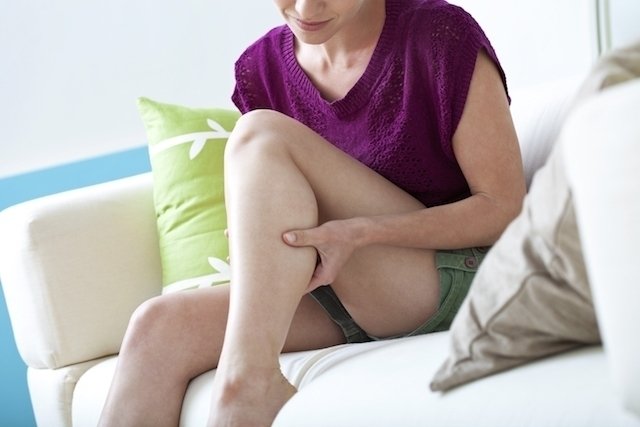Aching legs is mainly caused by poor circulation, also referred to as chronic venous insufficiency. This condition is characterized by weakened blood vessel valves that make blood return more difficult. It leads to symptoms like varicose veins and heaviness, tingling and cramps in the legs.
Aching legs that present with other symptoms, such as pain, weakness or difficulty walking may be a sign of other conditions, however, like a muscle problem, arterial insufficiency or diabetic neuropathy. Check-out what else can cause leg pain and what to do.
To confirm the underlying cause of tired and aching legs, you should see a doctor for assessment and testing as needed.

What causes tired and aching legs?
Aching legs can be a sign of:
1. Chronic venous insufficiency
Poor circulation, also known as chronic venous insufficiency, causes discomfort and other leg symptoms such as heaviness, tiredness, pain, tingling, cramps and swelling.
This condition is very common, and usually forms varicose veins, which are small vessels that can be visible or deep and not obvious. It is related to family genetics, although some risk factors contribute to its appearance, such as obesity, standing for a long time, wearing high heels or a sedentary lifestyle.
How to treat: Treatment is recommended by an angiologist or vascular surgeon, and is aimed at symptom relief, such as the use of compression stockings, analgesics or medications that promote blood flow. Surgery may be recommended depending on the severity of each case.
2. Peripheral artery disease
Peripheral artery disease is characterized by poor circulation that affects the arteries. It is more serious the chronic venous insufficiency and leads to more serious, intense symptoms, as arteries are responsible for delivering oxygen and nutrients to the body's tissues.
The most common symptom is pain in the legs when walking, which improves with rest. Other possible symptoms include tired and aching legs, tingling, cold and pale feet and legs, erectile dysfunction and the appearance of wounds that do not heal.
How to treat: The angiologist may recommend healthy lifestyle habits, such as smoking cessation, weight loss, and regular exercise. Optimal management of diabetes or high blood pressure are also essential, as they are major risk factors for this disease. Cholesterol medication and circulation medication may be prescribed, while severe cases may require surgical intervention.
3. Lack of physical activity
Lack of physical exercise causes muscle atrophy. This makes it increasingly difficult to perform physical tasks and leads to symptoms like aching legs, weakness, tiredness, cramps and shortness of breath.
People who are bedridden or sit for prolonged periods of time, as well as people with lung, heart or neurological disease, are especially effected by by muscle weakness.
How to treat: to prevent and treat muscle weakness, it is necessary to exercise regularly by participating in physical activities such as walking, water aerobics or weight training. Activity should ideally by first approved by a doctor and guided by a personal trainer.
4. Diabetes
When diabetes is not well-managed for many years, it can cause damage to the body's nerves. This is a condition referred to as diabetic neuropathy. This change mainly affects the feet, but can affect the legs, as well as other parts of the body.
The main symptoms of diabetic neuropathy include leg pain, burning,, tingling, a sensation of needles or shocks, or loss of sensitivity in the affected limb. It also leads to wounds that do not heal well, leading to difficulty walking and even amputation in more severe cases.
How to treat: Treatment is guided by an endocrinologist, and involves optimizing blood sugar levels with diabetes medications or insulin. There are other medications that the doctor may prescribe to relieve symptoms, such as analgesics, antidepressants and antiepileptics.
5. Muscle diseases
Diseases that affect the muscles are referred to as myopathies. They can cause a feeling of tiredness and weakness in the legs, as well as pain, tingling, cramps, stiffness, spasms and difficulty moving.
Aching legs caused by muscle disease is rare, but it is a symptom of the following conditons:
- Autoimmune inflammatory diseases, such as polymyositis, dermatomyositis or inclusion body myositis
- Muscle damage caused by medications, such as ciprofibrate, corticosteroids, valproate or etanercept
- Muscle intoxication, due to the consumption of substances such as alcohol
- Muscle inflammation caused by infections, such as HIV, CMV or toxoplasmosis
- Hormonal changes, such as hyper or hypothyroidism
- Muscular dystrophies, which are hereditary diseases in which there is degeneration of the membrane that surrounds the muscle, or other genetic diseases
Muscular changes can also be caused indirectly by metabolic or neurological diseases, such as amyotrophic lateral sclerosis or myasthenia gravis.
How to treat: Treatment is guided by the doctor depending on the underlying cause, which may include the use of medications to regulate the immune system, antibiotics or adjustments to the medications already used.
